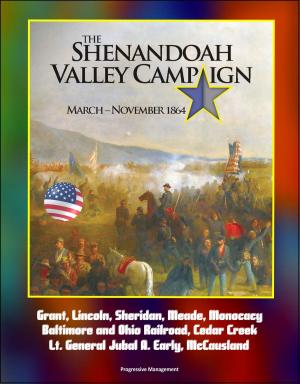U.S. Army Campaigns of the Civil War: The Civil War in the Western Theater 1862, plus Bibliography, Naval Strategy During the American Civil War - Lincoln, Grant, Battle of Shiloh, Vicksburg
Nonfiction, History, Americas, United States, Civil War Period (1850-1877)| Author: | Progressive Management | ISBN: | 9781310400810 |
| Publisher: | Progressive Management | Publication: | June 11, 2014 |
| Imprint: | Smashwords Edition | Language: | English |
| Author: | Progressive Management |
| ISBN: | 9781310400810 |
| Publisher: | Progressive Management |
| Publication: | June 11, 2014 |
| Imprint: | Smashwords Edition |
| Language: | English |
Three documents about the American Civil War are reproduced in this unique ebook. The anchor document, U.S. Army Campaigns of the Civil War: The Civil War in the Western Theater 1862, is a 2014 release of the Army Center of Military History. Topics and subjects covered include Lincoln, Jefferson Davis, McClellan, General Albert Sidney Johnston, General William T. Sherman, General Don Carlos Buell, Ulysses Grant, General Polk, General Pope, General Beauregard, Battle of Shiloh, New Orleans, Vicksburg, Baton Rouge, Port Hudson, General Bragg, Battle of Perryville, Battle of Iuka and Second Corinth.
In addition, a National Park Service document, The Civil War in the American West Bibliography, demonstrate the complexity and extent of the Civil War in the American West through a listing of published books on the subject, including recent scholarship accomplished since publication of Alvin Josephy's general work. To most Americans, the Civil War means a geographical focus on the region from the Atlantic Seaboard and the Gulf Coast to the Mississippi Valley. Indeed, the term "Civil War in the West" often is construed to mean the war in Kentucky, Tennessee and the Mississippi Valley and the other states flanking it, and even the Atlanta campaign. It would never occur to many Americans that anything connected with the Civil War happened farther "out West." Yet New Mexico Territory was an active theater of the war with two major battles and a number of lesser engagements, the Gulf Coast of Texas was under Union assault periodically, Confederate guerrillas operated in Colorado Territory, Confederate soldiers occupied the cities of Albuquerque, Santa Fe and Tucson; and the westernmost combat in the war occurred southwest of Phoenix in what now is Arizona at Picacho Pass when a detachment of Confederate Texas Mounted Riflemen ambushed a patrol of the Union 1st California Volunteer Cavalry.
A third document - Naval Strategy During the American Civil War - examines how the Union and Confederate naval strategies and new naval technologies affected the conduct of the American Civil War. With regard to the Union Navy's strategy, the effectiveness of the blockade, Western River Campaign, and amphibious operations were examined. Discussions on the Union blockade also touch on the effectiveness on Confederate blockade runners. The Confederate strategies of using privateers and commerce raiders are examined. Confederate coastal and river defenses are examined within the context of new technology, specifically with respect to ironclad ships and the use of mines, torpedoes, and submarines.
The paper shows how naval strategy did play a major role in the outcome of the Civil War. Although it cannot be said that naval strategies were singularly decisive, they certainly were vitally important and often overlooked in history books.
The Civil War in the Western Theater 1862 - The contest for the Western Theater in 1862 was monumental in scope and importance. Containing an area of about 230,000 square miles—roughly the size of France—the Western Theater extended from the Appalachian Mountains in the east to the Mississippi River in the west, and from the Ohio River in the north to the Gulf of Mexico in the south. Seven states— Kentucky, Tennessee, Georgia, Alabama, Mississippi, eastern Louisiana, and western Florida—lay within its boundaries. The region was vital to the Confederacy. Not only was it rich in human and agricultural resources, but it also contained the Confederacy's largest city (New Orleans, Louisiana), important ports (New Orleans and Mobile, Alabama), and critical industrial and railroad centers (Nashville and Chattanooga, Tennessee, and Atlanta, Georgia). Home to the mighty Mississippi River, towns such as Memphis, Tennessee; Vicksburg, Mississippi; and Port Hudson and Baton Rouge, Louisiana, controlled a water transportation system that was the lifeblood of both the South and the Midwest.
Three documents about the American Civil War are reproduced in this unique ebook. The anchor document, U.S. Army Campaigns of the Civil War: The Civil War in the Western Theater 1862, is a 2014 release of the Army Center of Military History. Topics and subjects covered include Lincoln, Jefferson Davis, McClellan, General Albert Sidney Johnston, General William T. Sherman, General Don Carlos Buell, Ulysses Grant, General Polk, General Pope, General Beauregard, Battle of Shiloh, New Orleans, Vicksburg, Baton Rouge, Port Hudson, General Bragg, Battle of Perryville, Battle of Iuka and Second Corinth.
In addition, a National Park Service document, The Civil War in the American West Bibliography, demonstrate the complexity and extent of the Civil War in the American West through a listing of published books on the subject, including recent scholarship accomplished since publication of Alvin Josephy's general work. To most Americans, the Civil War means a geographical focus on the region from the Atlantic Seaboard and the Gulf Coast to the Mississippi Valley. Indeed, the term "Civil War in the West" often is construed to mean the war in Kentucky, Tennessee and the Mississippi Valley and the other states flanking it, and even the Atlanta campaign. It would never occur to many Americans that anything connected with the Civil War happened farther "out West." Yet New Mexico Territory was an active theater of the war with two major battles and a number of lesser engagements, the Gulf Coast of Texas was under Union assault periodically, Confederate guerrillas operated in Colorado Territory, Confederate soldiers occupied the cities of Albuquerque, Santa Fe and Tucson; and the westernmost combat in the war occurred southwest of Phoenix in what now is Arizona at Picacho Pass when a detachment of Confederate Texas Mounted Riflemen ambushed a patrol of the Union 1st California Volunteer Cavalry.
A third document - Naval Strategy During the American Civil War - examines how the Union and Confederate naval strategies and new naval technologies affected the conduct of the American Civil War. With regard to the Union Navy's strategy, the effectiveness of the blockade, Western River Campaign, and amphibious operations were examined. Discussions on the Union blockade also touch on the effectiveness on Confederate blockade runners. The Confederate strategies of using privateers and commerce raiders are examined. Confederate coastal and river defenses are examined within the context of new technology, specifically with respect to ironclad ships and the use of mines, torpedoes, and submarines.
The paper shows how naval strategy did play a major role in the outcome of the Civil War. Although it cannot be said that naval strategies were singularly decisive, they certainly were vitally important and often overlooked in history books.
The Civil War in the Western Theater 1862 - The contest for the Western Theater in 1862 was monumental in scope and importance. Containing an area of about 230,000 square miles—roughly the size of France—the Western Theater extended from the Appalachian Mountains in the east to the Mississippi River in the west, and from the Ohio River in the north to the Gulf of Mexico in the south. Seven states— Kentucky, Tennessee, Georgia, Alabama, Mississippi, eastern Louisiana, and western Florida—lay within its boundaries. The region was vital to the Confederacy. Not only was it rich in human and agricultural resources, but it also contained the Confederacy's largest city (New Orleans, Louisiana), important ports (New Orleans and Mobile, Alabama), and critical industrial and railroad centers (Nashville and Chattanooga, Tennessee, and Atlanta, Georgia). Home to the mighty Mississippi River, towns such as Memphis, Tennessee; Vicksburg, Mississippi; and Port Hudson and Baton Rouge, Louisiana, controlled a water transportation system that was the lifeblood of both the South and the Midwest.















